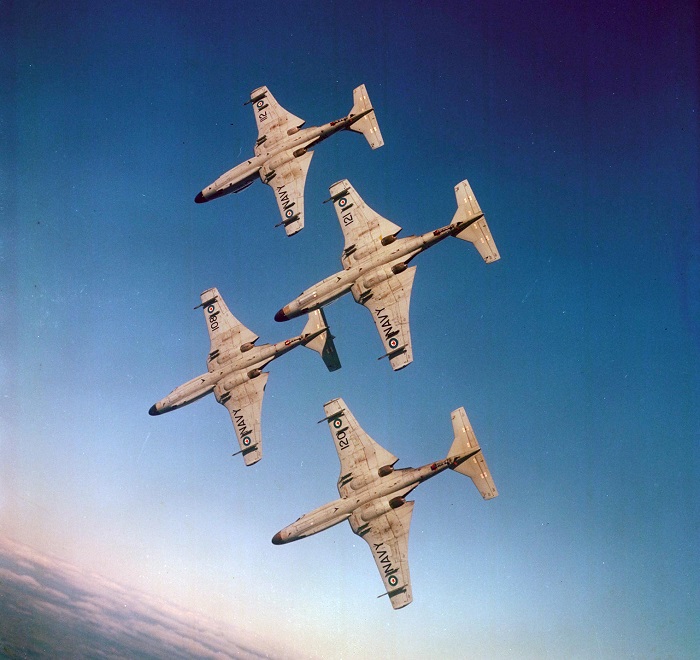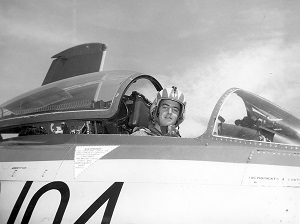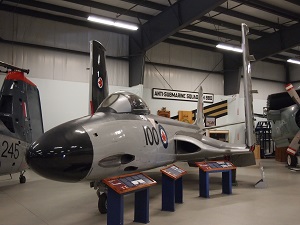|
RCN GREY GHOSTS AEROBATIC TEAM
Banshees were the primary aircraft of the short-lived Royal Canadian Navy Grey Ghosts aerobatic team. The team’s name was a play on the Banshee name and the RCN color scheme. The RCN’s Banshee fleet was too small to maintain a special contingent of aircraft for airshow service, so the team simply flew whichever active-duty Banshees were available at the time of each show.
The “Grey Ghosts” flying the McDonnell F2H-3 Banshee DND Photo, EKS-701
Memories of the Grey Ghosts
Aerobatics and the Grey Ghosts - Submitted by Geoff Craven, Col, RCAF (ret'd) (formerly Lt (P), RCN, Grey Ghost pilot)
(left) Lt (P) Georff Craven in the cockpit of a McDonnell F2H-3 Banshee (right) A McDonnell F2H-3 Banshee at the Shearwater Aviation Museum
In the first summer of my tour in VF 870 we spent much time practicing formation flying. Fighter aircraft do a lot of this anyway, what with two-aircraft instrument approaches, section tactics, intercepts and such; but as well, we were scheduled to perform in two flights of four aircraft each at the Canadian National Exhibition in Toronto in the first week of September. The first diamond-formation flight, led by Walton with Sloan and Fox as numbers 2 and 3 and Ed Hallett in the slot would put on a 15-minute precision aerobatics display; and the new boys would form a second diamond flight led by me, with Verronneau and Fuoco as numbers 2 and 3 and Mack Sherman in the slot. We would fly two or three low-level passes carrying all the weapons we could hang on our airplanes.
I thought my flight's job wasn't particularly demanding (quite wrongly, as it turned out) ; but we practiced two-plane and four-plane formation flying relentlessly that summer without, however, any formation aerobatics. This was the purview of the Squadron Commander's flight which practiced harder than we did. They'd taxi out in formation, blast off, depart for the low flying area, and come back two hours later with their flight suits and G-suits wringing wet, sweating like pigs. They'd usually be in bad humour, the afternoon sun causing bumpy conditions, or Wally Walton not being smooth enough, or Ed Hallett chewing out Alec Fox and Wally Sloan for not being symmetrically spaced. Their competition would be the RCAF Golden Hawks, the USN Blue Angels, and the USAF Thunderbirds; they had to be perfect.
Formation aerobatics was and still is a serious business, particularly at low level for air displays. Usually you practice at around 5000 feet to give yourselves similar conditions to those at ground level, and space to recover if something goes wrong. Your flight leader chooses a cross-roads on the ground as his reference point and orients his routine above it, as he would over the runways at whatever airfield the display is schedule for on The Day. In our case we practiced in June and July, performed the full routine at Shearwater (without ordnance) in August, did the same thing for the Admiral during a giant flypast later that month, and flew eight aircraft to Downsview Airport at Toronto at the beginning of September. By that time we were calling ourselves the Grey Ghosts, to which several Korean War destroyer veterans objected saying they had permanent rights to the name 'Grey Ghosts of the Korean Coasts' during their United Nations service there in the early 1950s. Predictably we paid no attention to them, and whenever formation and solo aerobatic displays were required of VF 870 from then on we called ourselves Grey Ghosts.
During the CNE of 1958 we stayed at a less than exclusive hotel in Toronto off Jervis Street. The best that could be said for it was that it had a very good buffet-style dining lounge called the Town and Country, but this wasn't much of an advantage in that our opinion of food was that it took up space better used for liquid refreshments. I have some recall for events other than our actual formation fly-pasts during the airshow. For example, Lieutenant Harry Swiggum (who did the commentary over the CNE broadcast system for us) came back to our room late one night and poured himself a nightcap in the bathroom where the light bulb had burned out. He mumbled thickly that the trick to drinking in the dark was to avoid swallowing the worms.
The day of our first display dawned hot and sunny and got progressively hotter and less sunny as the Toronto smoke and heat haze of late summer intensified. We set out for Downsview in our rental cars in the late morning, arriving there to find Peter Wiwcharuk and his ground crew and armourers wiping the last traces of dirt off our windscreens, fuselages, wings, tails and (on my flight's airplanes) a deadly-looking array of bombs, rockets, dummy Sidewinder missiles, tip-tanks, air-to-air banner canister, etc. We all briefed together, Ed Hallett and Alec Fox having attended a CNE Airshow briefing earlier in the day. Their account of this briefing, intervals between successive events, altitude separation in the waiting circuits, and other sophistications did nothing to improve our hangovers. By then visibility on the ground was barely a mile in haze, and we knew it wouldn't be much better in the air. But sailors don't care, so we all climbed into our birds together and put on a great show for Downsview's and our own groundcrew of an eight-aircraft formation start, taxi and takeoff.
Taxying out sweating in the cockpit canopy greenhouse effect, air conditioning making little perceptible improvement, I had to carry more power than usual to keep my bird and its load of four 500-pound bombs rolling; the sensation was of taxying through mud. Walton led his flight out to the button with my flight close behind. Getting takeoff clearance they rolled off down the runway in their close finger formation and disappeared into the shimmering heat haze. I lined up my murderous-looking flight, held it on the brakes while we turned up 100% power and transmitted "Go!" over the tower radio frequency. I released my brakes and oh, so slowly 126414 started to roll, my wingmen beside and behind me in our finger formation. Well, it was really hot that day, no wind and Downsview's runways were not long; there were apartment buildings all around the airfield even then, and we had full fuel and weapon loads. When we were halfway down the runway I thought we might not make it; at the two-thirds point I thought about aborting our flight's takeoff; as the end of the runway appeared through the haze I pulled the poor old birds up off the runway and we mushed along fifty feet over Shepherd Avenue for about a mile or more before we started to gain airspeed and altitude. Apartment-dwellers south of Downsview got a real show that day - probably better than spectators in the CNE grandstands that afternoon.
We had to work hard to stay close behind the first flight in the bumpy waiting pattern east of the Exhibition grounds, but eventually our time came and we roared past the grandstands as low as we could inside the breakwaters. Eight Banshees at low level, first a high-speed pass, then a slow-speed pass with gear and flaps down and power up at 90% deafening the crowd. Then Walton's flight separating from mine and going into their precision aerobatic routine, with two more passes by the grandstand for my flight while Walton and the others were re-forming after their 'Palm Tree'. I led my flight in a diamond formation into tight turns around the grandstand, bellies toward the crowd so they'd see our weapon loads; then up we went to rejoin the Boss and his flight and headed back to Downsview via Whitby and Kleinburg in smooth air above the haze. Both our flights switched to right echelons, broke and made stream landings at Downsview, light on fuel and relieved to be on the ground. Those kinds of flights are demanding and not without pucker factor. Two days later we repeated the show, but the Squadron Commander reduced our waiting time so we in the weapons flight could take off with lighter fuel loads. Downsview's apartment dwellers didn't get a repeat performance; sorry, people, once was enough.
Harry Swiggum said later that in his opinion, the practice and skills required for low-level formation aerobatics are not worth the risks; and that spectators are usually expecting three things: lots of noise, their next hamburger or hot dog, and maybe a spectacular aircraft accident. Nevertheless, squadrons such as the Snowbirds continue their performances with great skill, giving the crowds much pleasure and motivating young boys and girls to join the Royal Canadian Air Force and other navies and air forces. But only fellow pilots know how much they put into it, how good they are, and how risky it is.
During the rest of my time in VF 870, when we were away from Shearwater the Grey Ghosts usually performed as a single flight of four with a fifth aircraft as a spare. If all five were serviceable I would perform solo low-level aerobatics in the intervals when the first four aircraft were turning away from the display area and before they returned for their next pass. When we performed at Shearwater, Frank Willis and I did cross-over aerobatics in the intervals. This was fun and relatively safe because although the crowd's perception was that the two solos were separated only by a hair's-breadth during cross-overs in front of them, in profile we made sure we had plenty of room. At more than one Shearwater air show Frank and I started our takeoffs from opposite ends of the main runway and crossed in the middle, both of us having kept well to the right of the centerline. It wasn't smart but the crowd loved it. We stopped short of landing at opposite ends, though.
Perfectionists in the squadron complained on one occasion that my low-level loops were not round enough; they said I was flying arabesques rather than nice round O's; so the next time I practiced the Squadron Commander went up to the tower to coach me. With the circuit to myself one evening and half the base watching I came north over the Eastern Passage golf course at twenty feet and around 400 knots. At the button of Runway 34 Left I eased back on the stick and went up in a huge fat round loop. Inverted at the top Walton said to me "Now, hold it off a little!" so I eased the stick forward a little before pulling it back in the downward half of the loop. Wow, I thought, this is great! Then, Holy Shit - I'd better start pulling some G's on my way out of this or I'll bore a big hole right in the middle of the runway. I reefed back on the stick like I've never reefed before or since, the runway numbers coming straight up at me, the Banshee's nose slowly pulling out along the centerline, then much faster. Almost greyed out, I didn't know if there was enough room to make it - then we're out of it, no more than ten feet off the runway and the old bird is doing 400 plus knots … Walton says "That was great - do it again!" I allowed as how I didn't have enough fuel left, vowing to myself I'd never fly a loop as round as that ever again. That was the only time I ever thought I just might not make it in a Banshee.
Submitted by Gary LeDrew, Artist, Cape Breton Art: circa 1960 - 62 Every Friday morning at Shearwater the Grey Ghosts would shoot up the base for practice. This was an air show like nobody has seen. They would swoop between the hangers and even do it sideways with the wing tip just a few feet off the ground. They would dive at cars coming up to the main gate and if you dared to cross the tarmac they would dive right at you and leave you flattened. These guys were the best. I was so lucky to have seen them. I wish there were photos and videos but that was difficult then and they probably didn't want the higher ups to know what they were doing.
If you have any stories or photos of the Grey Ghosts that you like to share on For Posterity's Sake, please send an email to info@forposterityssake.ca. Photos could be of the aircraft, their pilots, some of their stunts, etc.
|



